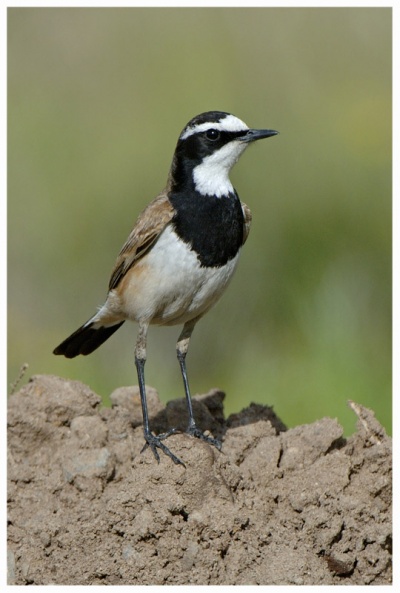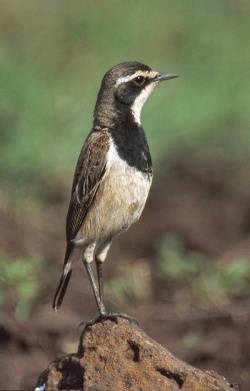(update link) |
m (Minor layout) |
||
| Line 36: | Line 36: | ||
The nest is made from straw, grass, and leaves, in a hole in the ground or a termite mound. The clutch consists of 3-4 eggs. | The nest is made from straw, grass, and leaves, in a hole in the ground or a termite mound. The clutch consists of 3-4 eggs. | ||
| + | ====Diet==== | ||
| + | The diet includes insects, especially ants. | ||
| + | ==Gallery== | ||
| + | Click on photo for larger image | ||
<gallery> | <gallery> | ||
Image:800bird3cP1302041.jpg|Moulting Juvenile <br />Photo by {{user|CollinBax|CollinBax}}<br />Agter-Paarl, [[South Africa]], January 2009 | Image:800bird3cP1302041.jpg|Moulting Juvenile <br />Photo by {{user|CollinBax|CollinBax}}<br />Agter-Paarl, [[South Africa]], January 2009 | ||
Image:21502Capped Wheatear 600x450 copy.jpg|Juvenile<br />Photo by {{user|nkgray|nkgray}}<br />[[Kgalagadi Transfrontier Park]], [[South Africa]], May 2006 | Image:21502Capped Wheatear 600x450 copy.jpg|Juvenile<br />Photo by {{user|nkgray|nkgray}}<br />[[Kgalagadi Transfrontier Park]], [[South Africa]], May 2006 | ||
</gallery> | </gallery> | ||
| − | |||
| − | |||
| − | |||
==References== | ==References== | ||
#{{Ref-Clements6thDec09}}#Avibase | #{{Ref-Clements6thDec09}}#Avibase | ||
Revision as of 21:37, 22 December 2016
- Oenanthe pileata
Identification
17-18 cm
- Black cap, cheeks, breast band
- White eye stripe and throat
- White underparts
- Buff flanks and lower belly
- Black tail base, centre of tail forms an inverted "T"
- White rump
- Black pointed bill
- Black legs
Juvenile: brown cap and cheeks
Distribution
Africa
Western Africa: DRC and Angola
Eastern Africa: Kenya, Tanzania, Zambia, Mozambique, Malawi
Southern Africa: Namibia, Botswana, Zimbabwe, South Africa and Lesotho
Taxonomy
Subspecies[1]
There are 3 subspecies:
- O. p. neseri:
- O. p. livingstonii:
- O. p. pileata:
- Southern Namibia and South Africa
Habitat
Stony plains, semi-desert, thornveld and short grassland.
Behaviour
Often seen perched on stones and fence posts.
Breeding
The nest is made from straw, grass, and leaves, in a hole in the ground or a termite mound. The clutch consists of 3-4 eggs.
Diet
The diet includes insects, especially ants.
Gallery
Click on photo for larger image
Moulting Juvenile
Photo by CollinBax
Agter-Paarl, South Africa, January 2009Juvenile
Photo by nkgray
Kgalagadi Transfrontier Park, South Africa, May 2006
References
- Clements, JF. 2009. The Clements Checklist of Birds of the World. 6th ed., with updates to December 2009. Ithaca: Cornell Univ. Press. ISBN 978-0801445019.
- Avibase
- Wikipedia
- BF Member observations
Recommended Citation
- BirdForum Opus contributors. (2024) Capped Wheatear. In: BirdForum, the forum for wild birds and birding. Retrieved 25 April 2024 from https://www.birdforum.net/opus/Capped_Wheatear







